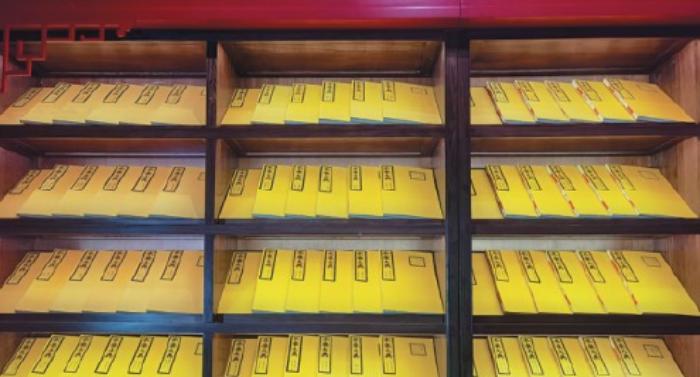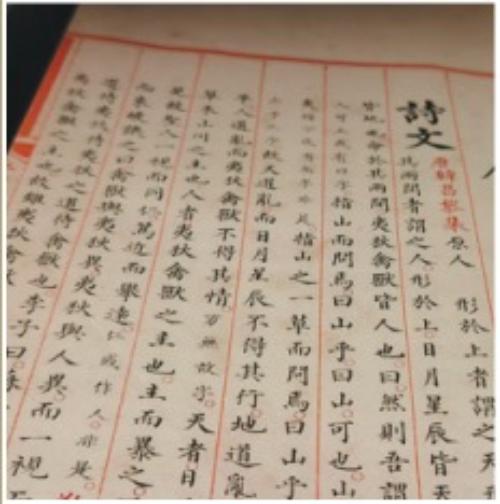 An exhibition featuring Yongle Dadian opens to the public in Beijing on June 1. It is estimated that some 370 million Chinese characters were included in the original work. (YI HAIFEI / CHINA NEWS SERVICE)
An exhibition featuring Yongle Dadian opens to the public in Beijing on June 1. It is estimated that some 370 million Chinese characters were included in the original work. (YI HAIFEI / CHINA NEWS SERVICE)
Little remains of the original edition of Yongle Dadian, an encyclopedia completed in 1408 after being commissioned by Emperor Yongle during the Ming Dynasty (1368-1644).
However, from what is left of the handwritten tome, which is also known as the Yongle Encyclopedia, it is not difficult to imagine just how impressive it was.
The encyclopedia not only charts the emperor's ambitions, but acts as a reference work for culture and knowledge in China.
It is estimated that some 370 million Chinese characters were included in Yongle Dadian, which comprised 22,937 volumes in 11,095 copies. The catalogs and reading guide alone took up 60 volumes.
Time has taken its toll, and only about 400 copies of a duplicated edition, or just over 3.5 percent of the total, are known to exist.
On May 31, the National Library of China in Beijing announced that the Yongle Encyclopedia Research Center would be established on its premises. The center will promote comprehensive studies of the encyclopedia by teaming up with other institutions in China and overseas.
Zhang Zhiqing, deputy head of the National Center for Preservation and Conservation of Ancient Books, said, "Studies at a deeper level will help us understand the significance of Yongle Dadian in a modern and global context."
Looking at the history of Yongle Dadian, we can see one mystery after another ... There are many puzzles for us to solve, so we expect the new center (The Yongle Encyclopedia Research Center) to harness our strengths and achieve breakthroughs.
Zhang Zhiqing, deputy head of the National Center for Preservation and Conservation of Ancient Books
The new center will organize academic symposiums for professionals and support the conservation and restoration of the encyclopedia's pages, Zhang said. It will also showcase the work's cultural significance to the public through exhibitions, lectures and other educational programs.
Zhang said that although the work is generally referred to as an "encyclopedia" in the English-speaking world, Yongle Dadian is different from modern encyclopedias that provide summarized introductions of items.
It was known as leishu ("category book").In this type of reference work, lengthy citations or entire works, rather than excerpts, are often included and categorized based on themes and the pronunciation of key words.
ALSO READ: Landmark exhibition to open at Palace Museum
More than 600 leishu works were compiled in ancient China, the oldest of them dating to the 3rd century. Some 200 survive either intact or partially. Yongle Dadian is the largest-scale leishu compiled, and is also generally considered one of the biggest paper-based reference books in history.
"It's more like an anthology of knowledge," Zhang said. "When the work was first compiled, it was planned to include everything, from the ancient Confucian classics to poetry, works on history, astrology, geography, medicine and many other topics."
Along with the announcement of the research center, a new gallery featuring Yongle Dadian opened to the public on June 1 at the NLC. Nine copies of the encyclopedia from the library's collection are on display, with a total of more than 40 other related ancient books, maps and cultural relics.
"Looking at the history of Yongle Dadian, we can see one mystery after another," Zhang said. "There are many puzzles for us to solve, so we expect the new center to harness our strengths and achieve breakthroughs."
Good and bad times
In imperial times, Yongle Dadian was meant to be read only by emperors.
In 1403, Zhu Di, or Emperor Yongle, had just won a civil war and seized the throne from his nephew. He commissioned Xie Jin, chief of the cabinet, to compile the encyclopedia in an attempt to appease intellectuals and academics angry with him for starting the war.
"He wanted to show that he ruled the country via culture, not the military," Zhang said.
 In this undated file photo, modern replicas of Yongle Dadian are displayed in the gallery at the National Library of China in Beijing. (WANG KAIHAO / CHINA DAILY)
In this undated file photo, modern replicas of Yongle Dadian are displayed in the gallery at the National Library of China in Beijing. (WANG KAIHAO / CHINA DAILY)
Leading a team of about 100, Xie handed in a draft the following year, but the emperor was not satisfied, because he thought that it mainly focused on ancient classics and was not inclusive enough.
Yao Guangxiao, a monk and a political adviser to Zhu Di, took over the job as editor-in-chief. More than 2,000 people joined the project to collect books and write the encyclopedia by hand. Over 7,000 kinds of books were eventually referenced in Yongle Dadian.
"It was incredible to finish such a huge project in a relatively short period, because there was no modern library cataloging system in those days," Zhang said.
Starting from just a single word, the editors expanded the subjects they handled. Numerous illustrations on architecture, geography, agriculture, antiques, along with human portraits, can be found in Yongle Dadian.
"In many cases, as long as a certain word appeared in a document, the entire original text would be copied in the encyclopedia, with clear citation for the emperor to refer to," Zhang said.
Starting from just a single word, the editors expanded the subjects they handled. Numerous illustrations on architecture, geography, agriculture, antiques, along with human portraits, can be found in Yongle Dadian
"Editors kept a word-for-word record of the original documents without paraphrasing or giving their own judgments, ensuring that key historical files throughout Chinese history survived intact."
For Zhu Di, the encyclopedia was a prized work.
As soon as construction of the Forbidden City was completed and the national capital was moved from Nanjing to Beijing in 1421, the emperor took the work, which was kept in the imperial palace, on his travels north.
About 100 years after his death, Yongle Dadian was passed down to Zhu Houcong, or Emperor Jiajing, who took the throne in 1521.
After a fire in the Forbidden City in 1557, the emperor realized there was a serious risk of losing the encyclopedia, so an ambitious project to duplicate Yongle Dadian was launched five years later.
After rigid scrutiny, 109 people were selected nationwide to copy the encyclopedia day and night for years.
Government departments ensured these workers had adequate supplies of writing brushes, paper, food and charcoal for fires to keep them warm.
"Immense resources and a national-level effort went into writing the book, reflecting the country's determination to protect a literary lifeline," Zhang said.
Emperor Jiajing died shortly before completion of the duplication was announced in 1567.
ALSO READ: Bronze horses, chariots from Qin Dynasty get new home
All surviving volumes of Yongle Dadian are from this duplication. No pages of the original work have been found, and it is not mentioned in any historical records after 1567.
 This undated file photo shows a copy of Yongle Dadian explaining the character ren, or "human". (WANG KAIHAO / CHINA DAILY)
This undated file photo shows a copy of Yongle Dadian explaining the character ren, or "human". (WANG KAIHAO / CHINA DAILY)
"Some people thought the original edition had been buried in Jiajing's mausoleum because the emperor loved it so much," Zhang said. He added that a more commonly accepted theory is that the edition was destroyed in 1644, when the Forbidden City fell into rebels' hands and was set ablaze, marking the end of the Ming Dynasty.
"However, it's still possible that this edition remains intact in an unknown location," Zhang said. "We'll keep looking for it. If we succeed, we can have a direct dialogue to ancient people. After all, Yongle Dadian was a trove of rich files related to literature, history, religion, philosophy and the sciences before the 14th century."
Yongle Dadian was favored by emperors, but when its popularity declined among rulers during the Qing Dynasty (1644-1911), its destiny inevitably changed.
In the early 18th century, the duplicated work was moved to Hanlinyuan, the imperial academy. According to statistics from 1794, there were 9,881 copies of Yongle Dadian at the academy, indicating that the work was basically still in good condition.
A political crisis emerged in the middle of the 19th century, and the emperors, several of whom succeeded to the throne in childhood, appeared to have little energy and interest in the encyclopedia.
The work's darkest days came after 1860, when Beijing fell to invading Anglo-French forces during the Second Opium War (1856-60). Scholars working at Hanlinyuan had taken copies of the encyclopedia home since then.
The number of copies (of Yongle Dadian) seems tiny among the 40 million books in our library, but they are a milestone for the lineage of Chinese culture.
Chen Hongyan, deputy director of the ancient books department at the library
According to records from 1875, fewer than 5,000 copies of the work remained. Just one year later, the figure fell to around 3,000, before dropping to 870 in 1892. In 1900, Hanlinyuan became a war zone during the Boxer Rebellion, and hundreds of copies were burned or taken overseas. By 1909, only 64 remained.
"When the country became weak, ancient books were scattered," Zhang said. "While it gained strength, they were reunited. The fate of books reflects a country's destiny."
Retrieval efforts
After the monarchy fell, remnants of Yongle Dadian were included in the first collections at the National Peking Library-now the NLC. In 1912, the author Lu Xun, an official with the Ministry of Education, led a campaign to bring the former royal collection to the library.
Since then, scholars, collectors and librarians nationwide have devoted their efforts to retrieving lost copies of the work, either through donations or by buying them in China and overseas. The volumes they obtained were brought to the national library.
ALSO READ: Exhibition showcases Tang and Song dynasty arts
Lost copies were also returned through diplomatic channels. For example, in 1954, the Soviet Union sent 52 copies to China, while the following year, three were returned from East Germany.
Thanks to these efforts, in recent decades, the national library has housed the biggest collection of Yongle Dadian.
Chen Hongyan, deputy director of the ancient books department at the library, said the institution now has 224 copies of Yongle Dadian, including 62 temporarily stored at the National Palace Museum in Taipei.
During World War II, the copies now in Taipei was secretly taken to the Library of Congress in the United States to avoid them being seized by Japanese invaders. They were brought to Taiwan in 1965.
"The number of copies seems tiny among the 40 million books in our library, but they are a milestone for the lineage of Chinese culture," Chen said.
The 400-odd copies of Yongle Dadian known to exist are in the hands of 30 public institutions or collectors in seven countries, Chen added.
In July, two copies surfaced at an auction in France despite the encyclopedia not being thought to exist in that country. They were bought by a Chinese collector for 65 million yuan (US$10 million).
Although the French auction house claimed both copies were bought from a Qing Dynasty official in the 1870s, Zhang doubted this and said they may have found their way overseas through different routes.
He said one copy is a successor to a volume in the British Library, and the other is a predecessor to a volume that is now in Vietnam.
 This undated file photo shows illustrations from Yongle Dadian. (WANG KAIHAO / CHINA DAILY)
This undated file photo shows illustrations from Yongle Dadian. (WANG KAIHAO / CHINA DAILY)
Zhang, from the National Center for Preservation and Conservation of Ancient Books, said, "It's probably no coincidence, because the French School of the Far East (an Asian studies academy) operated in Vietnam during the colonial period."
Another copy, bought for "a relatively low price" by the NLC from a Canadian Chinese collector in 2013, includes a section on the character hu (lake), as do two other copies already housed at the library.
Zhang said: "There are so many clues to clarify. After establishing the new research center, and completing more cross-border joint studies, we expect to get a clearer picture of how copies of the encyclopedia became scattered worldwide."
New discoveries
Xie Dezhi, an associate researcher at the NLC, said, "Thanks to Yongle Dadian, many chapters of ancient works that disappeared in the past were recovered."
For example, during the Qing Dynasty, scholars were able to find a total of 385 books and excerpts from works that were thought to be lost by referring to Yongle Dadian. In the 1930s, even with the encyclopedia in pieces, Zhao Wanli, a librarian, located another 200 works in its pages.
By referring to the character shui (water) in two copies of the encyclopedia on display at the NLC, visitors can learn about the original text for Commentary of the Water Classic, a geography book from the 6th century.
Chen, from the NLC, said: "When a new page of Yongle Dadian is found, it is big news for us. We always have new findings, which allow us to correct previous misunderstandings. These findings can perhaps offer much inspiration for our daily lives today."
For example, in one copy of the work that was found in Shandong province in 1983, and refers to the character men (gate), scholars discovered a detailed record of evolving styles of front doors in ancient China, which was rare in earlier copies.
For the NLC, obtaining just a single copy of Yongle Dadian is no easy task.
Zhao Qian, a researcher from the library, said ancient Chinese books have been in high demand on the auction market in recent years, and prices have risen significantly. As an example, Zhao cited the two copies in France that fetched 65 million yuan.
In other countries, copies of Yongle Dadian have been listed as key cultural relics, making it difficult to repatriate them to China.
Meanwhile, digitization has opened a new door to building a database for the encyclopedia.
The NLC has acquired a total of about 70 copies from the United Kingdom, Germany, the US, Japan and Ireland through photocopied duplicates. Digitized versions of all copies of the encyclopedia collected in public institutions on the Chinese mainland have been published by the national library.
READ MORE: Empresses of China's last dynasty make US debut
Zhang said, "People in the Ming Dynasty left a huge knowledge graph for us. With new technical approaches, we can manage and analyze digitized information in a scientific way and construct a framework to better understand Chinese civilization."


